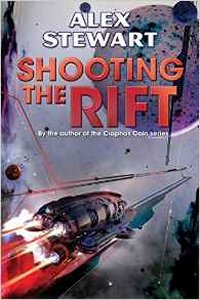Paul Di Filippo reviews Alex Stewart
Shooting the Rift, by Alex Stewart (Baen 978-1-4767-8118-1, $16, trade paperback) April 2016
 Unless I am radically misinterpreting his bibliography, Alex Stewart has written upwards of a score of novels, all of them in the Warhammer franchise and under the penname of Sandy Mitchell. Shooting the Rift appears to be his first “independent” production under his own name. Except that he also began publishing short fiction as Alex Stewart as far back as 1982. And so he emerges into the arena of “creator-owned” SF novels (to port over a term from comics) as a seasoned, dual-track professional with what we must assume is a tale compelling enough to make him break his old patterns of work. And in my judgment, he is fully justified in singling out this tale for special exhibition, for he has come up with a genial, clever, colorful, rousing space opera that resonates with the classic work of Poul Anderson, James Schmitz and A. Bertram Chandler—not coincidentally, all of them past masters with Baen editions!
Unless I am radically misinterpreting his bibliography, Alex Stewart has written upwards of a score of novels, all of them in the Warhammer franchise and under the penname of Sandy Mitchell. Shooting the Rift appears to be his first “independent” production under his own name. Except that he also began publishing short fiction as Alex Stewart as far back as 1982. And so he emerges into the arena of “creator-owned” SF novels (to port over a term from comics) as a seasoned, dual-track professional with what we must assume is a tale compelling enough to make him break his old patterns of work. And in my judgment, he is fully justified in singling out this tale for special exhibition, for he has come up with a genial, clever, colorful, rousing space opera that resonates with the classic work of Poul Anderson, James Schmitz and A. Bertram Chandler—not coincidentally, all of them past masters with Baen editions!
We inhabit the indefinite future so beloved and essential for this subgenre—however unrealistic a scenario such spoilsports as Charles Stross and Kim Stanley Robinson might deem it—wherein humans have spread out to colonize a fair portion of the galaxy—the Human Sphere, to be precise. Within this cubic tract are many polities, two of which are at our focus: the Rimward Commonwealth and the League of Democracies. Our narrator and hero, Simon Forrester (his surname being a nod, one assumes, to author C. S. Forester of Hornblower fame), is a member of the Commonwealth. His family is a well-regarded one that has contributed Naval officers for generations. In fact, Simon’s mother is a warship Captain, and his sister, Tinkie, might have become one also, had she not joined the Marines instead. When we meet Simon, he has just been booted out of his university for selling test answers and term papers, obtained thanks to his superior hacking skills. (The average citizen of this era is fully rigged out with neuroware, mentally linked to the immense dataverse and able to communicate more or less telepathically with anyone else so equipped.) Could Simon perhaps redeem himself by entering the Naval Academy and following in the family tradition? Unlikely, since he is after all a male!
Here is the first and most charming fillip of the novel. The Commonwealth is, if not a pure matriarchy, a society in which female privilege is the reality. By flipping the gender roles of Western society in the twenty-first century, Stewart gets a nice boost of cognitive estrangement so essential to good SF. And he never overplays his hand or engages in crude, reductionist satire. This is just the way such a setup would work, for all practical reasons.
In any case, denied a Naval career, Simon is left at loose ends and so is ripe for recruitment by his Aunt Jenny, a secret Intelligence officer, who has been impressed by his hacking skills and general brashness. She manages to get him enrolled onboard a Guild trader ship, the Stacked Deck, as cover story, and sends him out into the harsh and merciless universe to further the cause of the Commonwealth against the League. Captain Remington proves a fine mentor, and crewmember Clio Rennau an intriguing pal and potential if prickly love-interest. Meanwhile, Simon, who has never been absent from his home planet before, starts his galactic education by fire.
All of this occupies about the first hundred pages of the novel, and is delivered in such a smooth, engaging and even touching voice, leavened with wry humor, that the reader is pulled into the tale as if into a recitation by some old raconteur friend. Simon being an antihero and a bit of a rogue (maybe Harry Harrison’s Slippery Jim DiGriz and Keith Laumer’s Retief should be trotted out as influences at this point), we never get suffused with pretentious gravitas. The droll chapter headers—“In which Remington gives and receives a blessing.”—are plainly modeled on such literary classics as Tom Jones: “A short description of squire Allworthy, and a fuller account of Miss Bridget Allworthy, his sister.” Really, the picaresque novel of the eighteenth century—a time of analogous terrestrial empires and explorations—should be used more often for space operas, and Stewart gets big kudos for choosing this model.
The next exciting section of the novel finds Stewart honing his spy chops and his Guild craft on the world of Numarkut. After this, the ship runs afoul of the League, there’s a long stint on a fortress-cum-prison moon, and finally a slambang action climax and neat tidying up of all threads. We leave Simon in an intriguing new position, set for further adventures.
The title of the book refers to the common means of hyperspace travel in this future, and Stewart makes that technology as accessible and relevant as the neuroware, genetic engineering, anti-gravity, and other assorted techno-furniture of the milieu. His various venues—really only about three or four, which is perhaps the one aspect of sparseness in an otherwise well-stuffed book—are limned with vigor, vividness and vivacity. The personages are all true-to-life, delivering fine banter and plot-propelling dialogue, arising out of fully believable motivations and drives and desires.
Although I have made a lot of comparisons here to old-school SF, Stewart’s book does not feel like a pastiche or homage, is not creaky nor fusty. Perhaps not as quite as cutting-edge hip as Corey’s Expanse series, it nonetheless emerges authentically from the current moment in both the culture and the genre, representing the best of what ambitious adventure SF has always done and can plainly continue to do.





